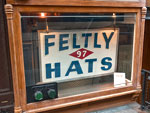From the Bowery Boys website:
"Red Hook, Brooklyn, the neighborhood called by the Dutch 'Roode Hoek' for its red soil, became a key port during the 19th century, a stopping point for vessels carry a vast array of raw goods from the interior of the United States along the Erie Canal. In particular, two manmade harbors were among the greatest developments in Brooklyn history, stepping in when Manhattan's own decaying wharves became too overcrowded.
With these basins came a mix of ethnicities to Brooklyn, and along with new styles of row houses came the usual mix of vices—saloons and brothels along Hamilton Avenue. This fostered the development of crime along the docks, and Red Hook soon witnessed firsthand the opening salvos of 20th Century organized crime.
How did the history-rich, nautical neighborhood go from a booming center of employment to one of the worst neighborhoods in the United States by the 1990s? And can some surprising twists of fate from the last twenty years help Red Hook return to its glory days?
Featuring: Revolutionary War forts, shantytowns, Vaseline factories, famous gangsters, the gateway to Hell, and cheap Swedish furniture!"
